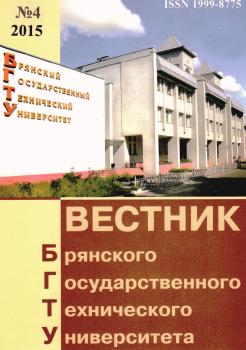National Research Nuclear University “MEPhI” (Professor)
Bauman Moscow State Technical University (Professor)
Bryansk, Bryansk, Russian Federation
employee
Bryansk, Bryansk, Russian Federation
Grinding is the most common finish stage of friction surface machining. The surface machined is transferred in a non-equilibrium state in consequence of thermal and power effect at grinding. During friction part material strives for a more equilibrium state in microcontacts of surface layers due to the presence of a considerable share of a defect phase formed at finish grinding. It is evident that the process of the material transition from a nonequilibrium state (after grinding) into a more equilibrium state (at surface runningin) and mainly defines the character of modes and finish grinding effect upon surface tribotechnical indices (wear intensity, runningin period, constant of friction). The researches were carried out in two stages. In the first stage at the expense of changes of grinding depth and time of surface sparking-out (that is, the intensity and duration of thermal and power effect of grinding on a sample) there were formed surface layers with different parameters on steel samples. In the second stage of investigations there were carried out tribotechnical tests of grinded samples under the same conditions and, in such a way the effect of grinding modes on surface durability was evaluated. On the basis of the results there were revealed the dependences of sample wear on test time and also dependences for the computation of wear intensity in grinded surfaces made of different structural materials. It is shown that at the abrasion there are possi-bilities for considerable increase (up to several times) of machinery surfaces durability by means of grinding depth changes and time of surface sparkingout, as these technological modes define the intensity and duration of thermal and power effects of abrasion upon a surface layer.
surface durability, finish grinding, technological modes of working, tribotechnical tests
1. Myshkin, N.K. Friction, Lubrication, Wear. Physical Fundamentals and Technical Applications of Tribology/ N.K. Myshkin, M.I. Petrokovets. - М.:Physmathlit, 2007. - pp. 368.
2. Bishutin, S.G. Durability increase of machinery part surfaces at finish abrasion / S.G Bishutin // Bulletin of Bryansk State Technical University. - 2013. - №2. - pp.11-15.
3. Bishutin, S.G. Quality and Durability in Grinded Surfaces of Motor Car Parts/ S.G. Bishutin. - Bryansk: Ten, 2011. - pp. 100.
4. Suslov, A.G. Calculation automation of normal contact rigidity in joints of grinded part flats/A.G. Suslov, S.G. Bishutin, D.M. Medvedev, V.A. Khandozhko// Bulletin of Braynsk State Technical University. - 2006. - №2. - pp.135-139.
5. Bishutin, S.G. Durability of Machinery Part Surface Layers Formed at Grinding/ S.G. Bishutin, M.I. Prudnikov; under the editorship of S.G. Bishutin. - Bryansk: BSTU, 2010. - pp. 100.
6. Bishutin, S.G. Machinery and Mechanism Parts Durability: Manual/S.G. Bishutin, А.О. Gorlenko, V.P. Matlakhov; under the editorship of S.G. Bi-shutin. - Bryansk: BSTU, 2010. - pp. 112.
7. Bishutin, S.G. Simulation of surface microroughness formation at grinding taking into account tool wear/ S.G. Bishutin // Mechanical Engineering Problems and Machinery Reliability. - 2005. - №1. - pp.78-82.














